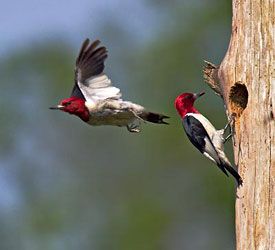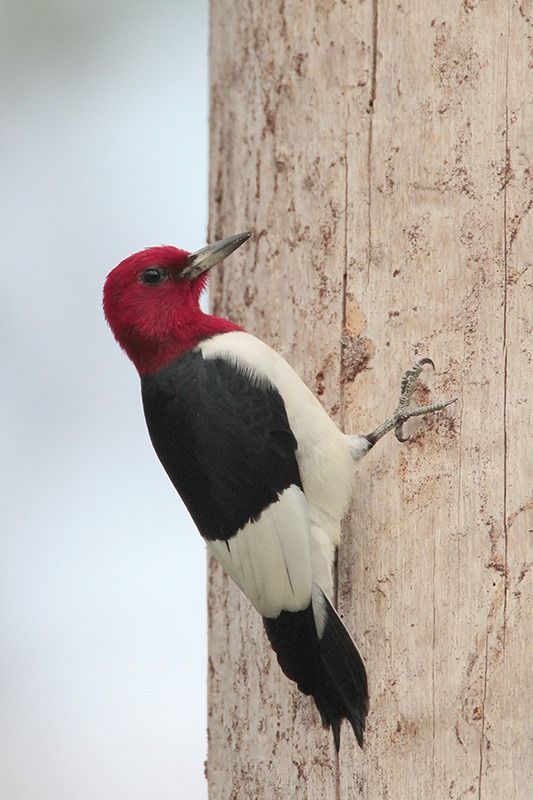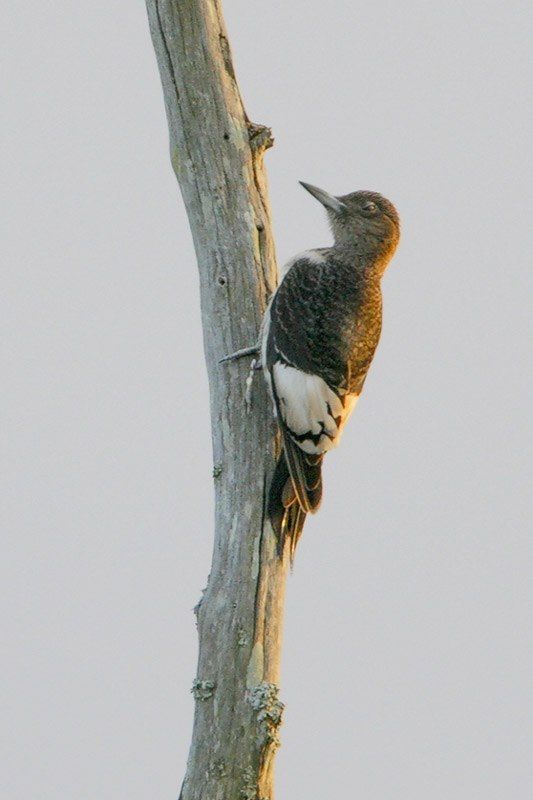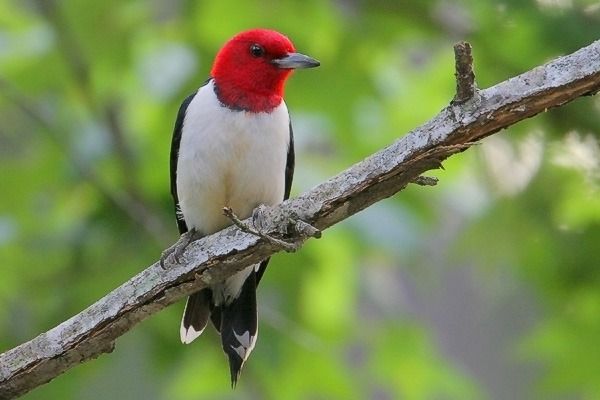Red-headed Woodpecker

© Wayne Nicholas
Melanerpes erythrocephalus
Family: (Picidae) Woodpeckers
Preferred Habitat: Open woodlands wherever dead trees may be found.
Seasonal Occurrence: Uncommon in all seasons.
Profile by Glenn Olsen: This is a beloved woodpecker of my childhood. As a skinny eight year old, the pastures of the farm with a sprinkling of trees were my backyard and playground. It may be difficult to understand the joy, pleasure, and excitement that reaching into the nest cavity of a Red-headed Woodpecker in a fencepost holds for an eight year old nature lover. And it is almost indescribable. These forays (dare I say intrusions) into the lives of woodpeckers and many others were the early learning experiences that influenced my fascination with birds and all of nature.
The adult of this bird is not likely to be misidentified. With its entire head true red, blue-black upper back, a wide white bar across the lower back (secondaries and rump) and a blue-black tail, this bird is dressed to impress!
Male and females look alike and the immature birds have a similar body pattern of color, but the head is brownish, often with a faint reddish wash or streaking. Not coincidentally, the pastures with scattered trees are exactly the preferred habitat of this species. Within its range, park-like settings, open woodlands, pastures, and fields with a thin border of trees are all excellent habitat for this species. Add in a good number of trees that have been dead for a few years and you have great breeding habitat.
Unfortunately in our society today, if a tree or a limb dies for any reason, it is considered ugly or a hazard and is forthwith cut off, if a limb, or cut down to the ground if a tree. We could easily and with minimal to no risk leave dead trees topped out and standing from eight feet to thirty feet, creating great habitat not only for all woodpeckers but also for many other species of birds. It seems that many people are unaware of the importance and necessity of woodpecker holes (nest cavities) to secondary cavity nesters. Birds such as Eastern Screech-Owl, Eastern Bluebird, Wood Duck, American Kestrel, and many others depend on old woodpecker holes and natural cavities for their nests. Alternatively, we can add man-made cavities (nest boxes) designed for the birds that live in our neighborhoods. Adding these nest boxes will help other birds even if you do not have Red-headed Woodpeckers in your neighborhood.
The population of Red-headed Woodpeckers is declining primarily due to loss of habitat, but we are fortunate to have a few families in the Houston area. To see this gorgeous bird, check out the Edith L. Moore Nature Sanctuary, Bear Creek Park, W.G. Jones Forest, or Jones Park and Nature Center where these birds still find a home.
Profile by Aidan Healey: The Red-headed Woodpecker can easily be recognized by – you guessed it – its red head. In fact, the Red-headed Woodpecker’s red head is so vibrantly colored that scientists have given it a Latin name that also means 'woodpecker with a red head.' Aside from its bright red head, the Red-headed Woodpecker is starkly patterned black and white. It is black-backed with a white front, and large white patches on the wings flash boldly in flight. Red-headed Woodpeckers do not acquire the striking adult plumage until after their first winter; young birds have a similar pattern but are speckled brown and have lighter brownish heads.
Red-headed Woodpeckers live in woodland and savanna habitats where there is lots of open space under the tree canopy. They can be found in both natural and urban settings, as long as there are enough food sources and plenty of tree cavities for nesting. Family groups of Red-headed Woodpeckers often live nearby and travel together, so if you see one, look around for others nearby.
-
Cornell Lab of Ornithology

© Greg Lavaty, www.texastargetbirds.com

© Greg Lavaty, www.texastargetbirds.com

© Greg Lavaty, www.texastargetbirds.com




















